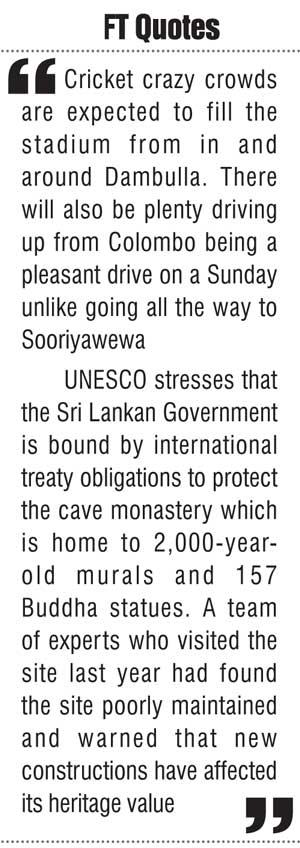Friday Nov 21, 2025
Friday Nov 21, 2025
Saturday, 27 August 2016 00:07 - - {{hitsCtrl.values.hits}}
Every now and then Dambulla hits the headlines. It’s either about neglecting the paintings in the famous Rock Temple. Or it is a problem with the cricket ground. Or it’s about the rotting tomatoes and other vegetables in the wholesale market.
Right now, the Dambulla Cricket Ground is being made ready for Australia-Sri Lanka ODI tomorrow. Sooriyawewa in distant  Hambantota is now ignored and Dambulla is the preferred venue. After all it was the present SLC boss’s pet project a few years back.
Hambantota is now ignored and Dambulla is the preferred venue. After all it was the present SLC boss’s pet project a few years back.
Then there was a dispute about the leasing arrangements. The land belongs to the Dambulla Temple. Also facilities were thought not up to standard, particularly the lights for day night matches. The problems have been sorted out and it’s back in action!
Cricket crazy crowds are expected to fill the stadium from in and around Dambulla. There will also be plenty driving up from Colombo being a pleasant drive on a Sunday unlike going all the way to Sooriyawewa.
Off the Heritage list?
Meanwhile, Dambulla Rock Temple paintings were the hot topic of discussion following the comments made by UNESCO Director-General Irina Bokova at the end of her four-day visit to Sri Lanka. She said she raised the maintenance issue at the Dambulla Rock Temple with local authorities during her visit to the island.
There was controversy as to whether she mentioned that there was a threat of Dambulla being struck off the list of World Heritage Sites if the centuries-old paintings are not maintained properly. While it was mentioned in some media that the Director-General indicated such a threat at a media conference, her office later released a statement saying that no reference was ever made to its de-listing as a World Heritage Site.
Whatever her comments were, it is obvious that there is a problem about the maintenance of the paintings. A little over a year ago, media reported that the Archaeological Department had started work on conserving the Dambulla Rock Temple murals and statues, but thereafter no follow-up was done by the media.
UNESCO stresses that the Sri Lankan Government is bound by international treaty obligations to protect the cave monastery which is home to 2,000-year-old murals and 157 Buddha statues.
A team of experts who visited the site last year had found the site poorly maintained and warned that new constructions have affected its heritage value, Director-General Bokova said, adding that a Buddhist monk at the temple has been resisting Sri Lankan Government efforts to take over the maintenance of the temple.
Whatever the problems are, it is the responsibility of the Government to ensure that such a valuable site is not allowed to perish. The caves date back to the first century when they had been turned into a temple by King Valagambahu (89-77 BC). King Nissanka Malla (1187-96 AC) of the Polonnaruwa era and the 18th century Kandyan King Kirti Sri Rajasinghe had renovated the temple enabling the large number of frescoes and statues to remain up to this day.
‘Vibrant fresh produce’
As for the brighter side of things, recently I read the impressions of an Australian travel writer, Tara Mathews, on her visit to the Dambulla wholesale market.
“On the morning we visited, the market was a busy hive of activity, open 24 hours. Brightly-painted trucks drove in bearing loads of bananas, coconuts, pumpkins and green beans, and the strong and lean men swiftly unloaded the sacks so they could be purchased.
“On the ground sat full boxes of round green avocados (locally known as butter fruit), green bananas still attached to the branch, carrots, beetroot and potatoes lightly dusted in fresh dirt and piles of thin, purple eggplant so bright that the colour made it look like a sugary lolly and not a fresh vegetable.” Incidentally, she is a vegetarian and edits a weekly newsletter ‘vegeTARAian’.